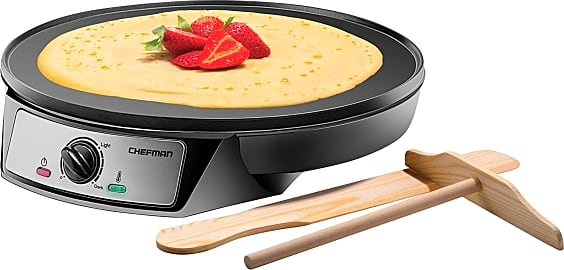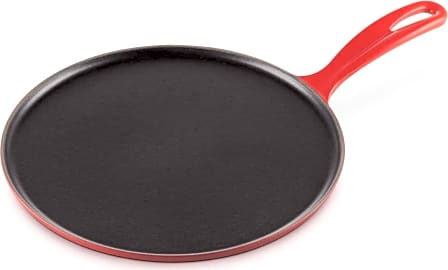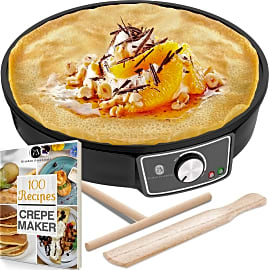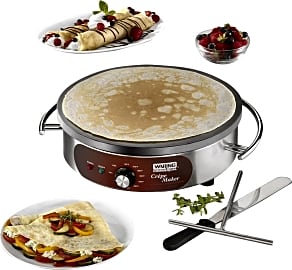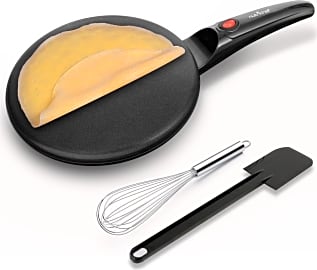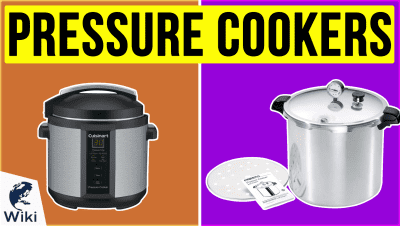The 8 Best Crepe Makers

This wiki has been updated 39 times since it was first published in March of 2015. Whether you prefer them sweet or savory, the perfect thin and crispy pancakes are easy to prepare right at home with one of these convenient crepe makers. Equipped with nonstick, flat griddles, these versatile machines are also great for fixing blintzes, tortillas, and toasted sandwiches. Many feature adjustable temperature controls and come with handy cooking tools like spatulas and whisks. When users buy our independently chosen editorial recommendations, we may earn commissions to help fund the Wiki.
Editor's Notes
March 26, 2021:
We updated the Chefman Electric, replacing it with a newer version of the same model. It has the same useful features while being more lightweight and heating up more quickly, making it more convenient to store and use.
The CucinaPro 1448 and Salton CM1337 were removed due to availability concerns. The NutriChef PKCYM15 was removed because it had issues with uneven heating, which can be a real dealbreaker for making something as thin and delicate as a crepe.
In its place, we added the NutriChef PCRM12. While this model doesn't have the same bells and whistles as the PKCYM15 (which came with a grill pan and a mold for making mini pancakes) it's a reliable option with a more powerful heating element that provides heat evenly across its nonstick surface.
February 02, 2020:
Delicious, delicate crepes don’t have to be a rare treat at a restaurant when you have one of these convenient crepe makers right in your kitchen. Most offer an adjustable temperature range, so you’ll have precise browning control, and many also come with handy utensils like batter pouring cups, batter spreaders, and spatulas. One such model is the Chefman Electric, which joins our selection today. It features a 12-inch nonstick grill pan, which makes it a good size not just for crepes, but also for making fried eggs, bacon, and more. It sports a powerful, 1,200-watt heating element with a knob for precise temperature control. Your creations are easy to remove once they’re done, and any food residue that’s left behind comes off quickly when you wipe it with a damp cloth. It’s backed by a one-year warranty, so you can buy it with confidence.
For another choice that delivers a lot of bang for your buck, check out the newly added Proctor Silex 38400, which incorporates eight heat settings for precise browning control. This makes it suitable for cooking anything from pancakes to flour tortillas and more. It sports a 13-inch cooking surface and a light weight of just over five pounds. It comes with a batter cup and spreader, and is incredibly easy to use: Just pour the batter, spread it, and flip it. Like the Chefman model, its nonstick surface wipes clean quickly once it’s cooled off.
For a model that’s used on a stovetop burner, look to the Le Creuset Cast Iron Pan, which comes with a highly durable nonstick surface, as well as robust enamel base. These make it suitable for all stovetops, and it can be placed inside an oven that’s heated to any temperature. Its base and handle boast a cheery red finish, and the handle is both comfortable to hold and includes a handy hanging hole. Like many of the others, it comes with a spreader and spatula.
Like any cooking surface, these get very hot when in use, so be sure to keep them out of the reach of small children, and supervise any young helpers in the kitchen closely.
For additional small appliances that can help you get delicious meals on the table in minutes, check out our lists of best waffle makers, best air fryers, and best pressure cookers.
Special Honors
Williams Sonoma Nonstick Crepe Pan This sturdy pan can be used on all cooktops, including induction, and is oven- and broiler-safe up to 500 degrees Fahrenheit. It’s coated both inside and out, so you can use little to no oil, with crepes that cook evenly and are easy to release. The coating also ensures it’s resistant to scratches and stains, and that it’s a breeze to clean. Unlike many others, it’s safe for use with metal utensils. The stainless steel induction base prevents warping. This dishwasher-safe choice is made in France and backed by a lifetime warranty. williams-sonoma.com
It's Easier Than You Think
Little did I know that there were machines like these that are so easy to use, and that within a few tries the technique would become second nature.
I used to be intimidated by crepes. I don't mean that I shrank from their presence or had bizarre Freudian nightmares about them. Oedipus and crepes, as far as I know, have nothing to do with one another.
I mean that I used to be intimidated by the prospect of making my own crepes. They're just so good, and you can fill them with anything! But they also seemed fragile to me, and I've never even particularly adept at making pancakes, which are much more forgiving.
Little did I know that there were machines like these that are so easy to use, and that within a few tries the technique would become second nature.
When you buy a crepe maker, it's a lot like buying an electric frying pan (there are gas versions, but they really aren't that necessary). The only real difference between the crepe maker and the electric frying pan is the depth of the cooking surface.
Electric frying pans tend to be deep and, well, pan-shaped, where crepe makers are relatively flat. That flatness makes flipping those paper thin crepes much easier.
Both items heat a simple cooking surface–either cast iron or nonstick aluminum–to your desired temperature. From there, it's all a matter of what you put on it and how long you cook it.
Personally, I'd recommend the cast iron if you can afford it, as non-stick surfaces are more likely to degrade over time and begin to stick. As long as you keep your cast iron plate properly seasoned (periodically rubbed down with oil), it should last you your whole life.
The Perfect Crepe Station
For all I know, you're about to become the world's best loved maker of crepes. The mayor of Paris (does Paris have a mayor?) will give you the keys to the city, and the French government will build you an apartment at the top of the Eiffel Tower. Or, maybe, you just want to make a couple of crepes on a lazy Sunday morning.
One really only needs to be mindful of the varying sizes of units that are available, as well as their heating needs. Deciding on an electric one versus stovetop, or a wider diameter versus one with a smaller footprint is solely dependent on personal preference.
Whatever your ambitions on the European continent, starting with the right crepe maker is paramount. Knowing what you actually want to do with it is even more so. Take a minute and think about your cooking habits with other foods. Translate that level of enthusiasm and hunger to your crepe creation, and the unit for you will become clear.
Earth Laughs In Flours
When buckwheat flour came to Europe from the east in the 12th century, the crepe was born. The buckwheat itself was cultivated with great success in the northwestern region of France known as Brittany.
As more American cafes and restaurants offer crepe options, the prices of such dishes rise and rise, which is all the more reason to invest in a maker of your own.
The crepes in those days were tougher and generally less common, and they were cooked on large iron plates over wood fires. As the price of white flour plummeted in the early 20th century, the crepe gained tremendous popularity throughout the classes, though the cooking methods remained much the same.
With the development of electric cookware in the middle of the 20th century, crepe making became easier and even more widespread. The past couple of decades have seen a drastic increase in crepe consumption in American urban centers, as the sweet treats have become a kind of bourgeois delicacy among the middle class.
As more American cafes and restaurants offer crepe options, the prices of such dishes rise and rise, which is all the more reason to invest in a maker of your own.


